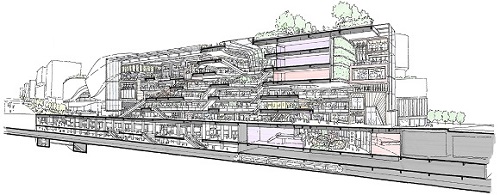September 28, 2021
New plans for a Transport Oriented Retail Destination in Nanjing
10 Design has recently released new plans for one of the largest transport-oriented retail destinations in Nanjing. In 2020, 10 Design won an international design competition to transform developer China Fortune’s 243,768 sq m site into a contemporary mixed-use project. In June 2021, the Nanjing Planning Bureau granted planning consent for the project, which is part of the wider redevelopment of the historic Nanjing Dajiaochang military airbase in China. The scheme is an evolution in design of transport-oriented developments to create a high-quality retail environment that fully integrates with the rail network and the extensive public realm.
The scheme envisions the integration of retail while preserving the 2.6 km airport runway which has been kept in its original form as a historic feature. The runway will be reimagined as a multifunctional cultural boulevard that doubles as a green pedestrian axis. The development involves three interconnecting buildings, incorporating a shopping mall, retail, cultural and office spaces along with a boutique hotel. Adjacent to the Nanjing Cultural Palace, this mixed-use project will run parallel to the remaining runway.
With two underground railway stations embedded into the site, connectivity is one of the key design drivers. The design includes a central glass box corridor with key entrances positioned directly on top of one of the railway tracks, providing a feature passageway for commuters to navigate through different levels of the scheme. All three buildings are connected via an underground retail spine and street-level pedestrian walkways: the pedestrian bridges provide further connectivity between the two shopping malls.
The coherent building facades echo the local culture through their metallic brick-shaped features that reference the adjacent Nanjing Cultural Palace and traditional ceramic facades. The facade pattern reflects the ancient city wall of Nanjing built in the early Ming Dynasty, further enhancing the historic and cultural connection to the city.
One of the challenges of the restrictive site was to maximise the pedestrian flow from two underground railway lines to the retail areas. It was resolved by creating a large underground ‘retail spine’ that connects and sits beneath the three main buildings on the site. A series of sunken plazas extend out to the street level, punctuating the ground level and bringing natural light into the subterranean areas. The basement retail area is an impressive double height space of up to 9 m – a unique underground space with natural light that would normally only be achieved at ground level.
The redevelopment of the airbase has been designed to echo the past whilst reflecting the future of Nanjing. This important new destination will provide the city with a cosmopolitan landmark, which in parallel responds to the cultural richness of its location.



(Source: 10 Design)
|
|
|



